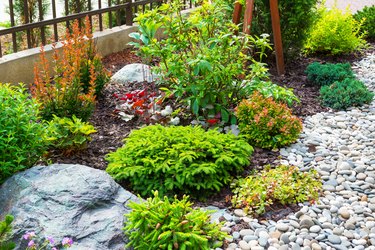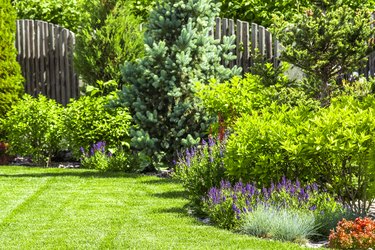Beautiful landscape beds don't happen by accident. They take careful planning to look their best — but beauty shouldn't be the sole focus. You'll want to make sure your beds are easy to maintain and, if necessary, simple to mow around. Whether you dream of a bountiful garden bed of herbs or neat and tidy rows of carefully plotted perennials and annuals, savvy gardeners draw out their planned flower beds on paper (or use a digital landscape design planner) before breaking ground to make sure they get the desired result.
Though this DIY project can be back-breaking labor, anyone with a shovel and a free weekend can easily create their own Eden — from a show-stopping front yard that gives your home a boost of curb appeal to a backyard oasis to enjoy in the cool summer evenings.
Video of the Day
Video of the Day
Types of Landscape Beds
Generally, landscape beds are broken down into two categories: borders and islands.
Border Landscape Beds
As their name suggests, border beds stretch alongside home foundations, beside sheds, along fences or anything else that offers a definitive backdrop. Border beds are viewed from only one side.
Border beds are often skinny, but proportion matters. An 8-feet-long border bed needs to be only about 3 feet deep. If it is any wider than that, it will be hard to weed and mulch the bed without stepping into it. If your bed is 100 feet long, however, it will look out of proportion if it's only 3 feet wide. In this case, you would need to make the bed about 12 feet wide to look fitting.
Tip
While proportion matters, there are no hard and fast rules about bed lengths and depths. It's really about aesthetics and making sure the proportions look acceptable. You can test this by laying out a garden hose where you want your bed and taking a look. If you need to make the bed deeper than 4 feet, include stepping stones or a walkway so you can easily access the entire bed.
Island Landscape Beds
The second type of landscape bed, an island, can float anywhere in your yard and can form any shape you like. Generally, straight borders work best for formal gardens, while more abstract shapes like kidney beans do best in informal outdoor spaces. Because they're not planted against a specific backdrop, island beds are seen from all angles and should look nice from every viewpoint.
How to Plan a Landscape Bed
It's a smart idea to plan out your landscape beds before you start digging up the yard. To map out your desired location, use landscape marking paint or a simple garden hose to test it out before you dig. When you think you have the shape you want, take a careful look around — verify that there's enough room to mow around any island beds you're planning.
In addition to checking for space, you should also examine the ground around you to make sure it isn't muddy, swampy or wet. If it is, you'll need to slightly mound your landscape bed and slope it for proper drainage. Also, note your proximity to your neighbor's property. They may not react kindly if ivy that you plant starts climbing their fence or if you're planning to plant a large shade tree where it would cast shadows over their pool or drop leaves into it.
As always, make sure you call your local utility companies or the national "call before you dig" hotline at 811 before you start digging. This way, you know you won't accidentally dig up any electric wires or ding a gas line. It's also a good idea to look upward, making sure tall plants won't hit any electric or phone lines when reaching their mature height.
Choosing Plants for a Landscape Bed

Picking out landscape plants before you even have planting beds may seem like jumping the gun, but doing so can save you a lot of trouble later. The first step in this process is to have your soil tested by a local garden center or local cooperative extension service. This test will reveal your soil's pH and what nutrients it's lacking. The test results will allow you either to choose plants that like your soil or amend your soil so the plants you desire can grow on it.
When planning a border landscape bed, you'll want to place your tallest plants in the back of the bed and shorter ones in front. In island beds, the tall plants will go in the middle, and the plants will get shorter as they work their way out toward the edge of the bed. Always consider the mature size of plants instead of simply looking at the much-smaller, younger versions of them at garden centers and nurseries.
If you want a low-maintenance landscape bed, choose native plants that you know will tolerate the local soil type and weather conditions without a lot of irrigation or help from you. Although you may want to plant colorful annuals like impatiens or petunias in a small bed, stick with perennials in large beds so you don't have to replant every year.
You should also choose your plant colors and timing when picking plants. Do you want evergreen plants for a nice color all year? Do you want flowering plants, and if so, what is the best way to stagger bloom times for color all summer long?
Once you've picked your plants, figure out how big they'll get and make sure your new beds are large enough to accommodate them when they're mature.
How to Build a Landscape Bed

Building a landscape bed is easy to do, but it's physically demanding, so take breaks often and find a helper if you're building a large bed.
- Mark the desired outline of your new landscape bed with marking spray paint or a garden hose.
- Take a square shovel and remove any sod and other vegetation in the area of your new bed.
- If you irrigate your lawn, stop watering a few days before building your bed. Wet sod is extra heavy, so you'll want to remove it when it's dry.
- Dig out the entire bed to a depth of about 6 inches. You'll want to keep the bottom of your new landscape bed flat unless you have drainage issues. In that case, mound or slope the bottom of the bed slightly so that water runs away from it.
- Take your shovel along the edges of your new bed and angle the sides slightly inward toward the bed. This helps keep topsoil and mulch in the bed where they belong. If desired, you'll install any physical border or edging around your landscape bed now.
- Fill the bed with fresh, clean topsoil and work in any soil amendments you want to add based on your soil test. Spread the topsoil evenly over the bed using a spade or, for larger areas, a garden rake.
- Add the desired plants to your landscape bed, taking care to place them properly where they'll fit into your design and get the amount of sun or shade they need.
- Spread mulch around your plants to a depth of 2 or 3 inches. If you've planted a tree or other plants with woody trunks, keep the mulch at least 6 inches away from the base of the plants to prevent insect damage.
